Aventon Sinch.2 ST Review | A Folder That Blazes Up Hills!?
Adventures or casual cruising await on this easy-to-store and easy-to-ride folding e-bike.
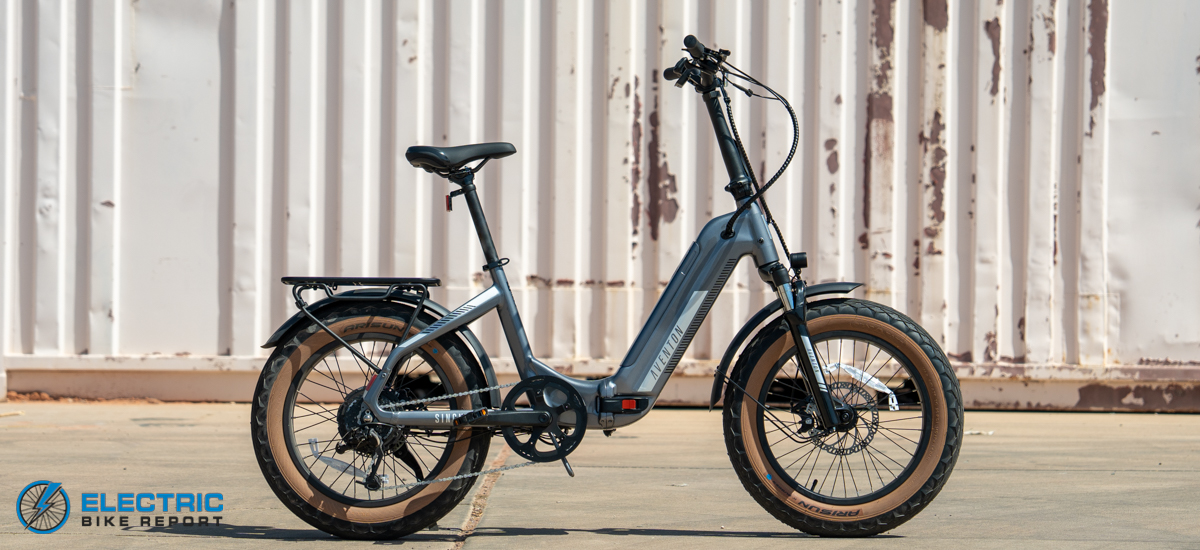
Thanks to its new torque sensor, the Sinch.2 rides and feels more like a non-electric bike. It’s responsive and capable in all of its four pedal-assist system (PAS) settings, both on the flat and when traveling uphill.
As a folding e-bike, the Sinch.2 collapses for easier transport and storage. The bike’s step-thru frame also makes it easy to ride by removing the need to swing a leg all the way over the saddle!
The Sinch.2’s visual styling hasn’t changed much, but we do appreciate the bike’s two new colors. The addition of bright, highly visible brake lights and turn signals adds to its already solid looks on top of adding an extra layer of safety!
Continue reading our full Aventon Sinch.2 review below for more!
 Pros
Pros- Pedaling is better than ever thanks to the new torque sensor. Better assistance getting up to speed, and more help when needed on hills in all PAS levels!
- Easily stored and easily ridden. The folding frame makes trunk transportation possible, while a relaxed rider position and low step-over height make it easy to ride.
- Looks great while keeping you safe. The paint colors look really bold in person and we love the brown wall tires, but the integrated brake lights / turn signals nail the aesthetic while helping alert others to your presence in traffic.
- Better battery efficiency as a result of the torque sensor / hub motor pairing. More mileage on this Sinch than the last version from the same size battery (so no weight increase there!)
- Versatile ride that can handle light off-roading. The 4” tires and front fork suspension help you cut across gravel and compact dirt areas giving you stability and absorbing some of the vibrations.
- The Sinch.2 ST has Aventon’s color LCD display w/app integration which is amongst the more easily seen and easy to use on affordable e-bikes.
 Cons
Cons- The lever throttle and trigger shifters work well, but their proximity to each other took some getting used to as they’re packed on top of each other pretty tight.
- Less of a con than a reminder: the Sinch.2 ST folds down pretty small, but at 68 lbs. It may be a bit difficult to place it where you need to when folded.
- Battery : Removable Internal Lithium-ion 48V 14Ah (672Wh) with LG cells
- Display: LCD Smart Easy Read Display with Backlight, Colorful screen with app
- Motor: 750W (peak) 500W (sustained) 48V Brushless Hub Motor
- Headlight: Included
- Taillights: Integrated into the seatstays with turn signal function
- Pedal Assist: Eco, Tour, Sport, Turbo
- Range: 36 -59 miles (EBR’s real-world testing)
- Throttle:Lever
- App:Proprietary Aventon app
- Claimed weight: 68 lbs.
- Maximum rider weight: 300 lbs payload weight
- Maximum load on the rear rack: 55 lbs
- Brakes: Mechanical disc brakes, 180mm rotors
- Fenders: Metal, included
- Fork: RST GUIDE-ML-20 45mm travel, with lockout
- Frame: 6061 Single-Butted Aluminum Alloy with Internal Battery
- Drivetrain: 170mm w/52T fron chain ring, 8-speed Shimano
- Grips: Textured sealed grips
- Saddle: Aventon by Velo
- Handlebar: Aluminum 31.8mm, 650mm
- Kickstand: Included
- Pedals: 3×3.5 in. Folding Platform
- Tires: 20” x 4” Ebike Rated, Gum Sidewalls
Aventon Sinch.2 ST Review: E-Bike Overview
Considering Aventon’s track record in general – and the original Sinch’s ability to meet the aforementiond goals in particular – we were excited to see where the second iteration of the bike would measure up.
We’ve been extremely happy to see torque sensors on all of Aventon’s new or updated models, and the Sinch.2 also includes this feature. We go into more detail about the differences between torque and cadence sensors in our article explaining throttle vs pedal-assist, but torque sensors like that on the Sinch.2 allow for motor assistance that mimics the feel of a non-electric bike by responding to the amount of work the rider is performing. Essentially, the harder you pedal (or the more resistance you encounter going uphill), the more the bike’s motor helps you. This allows for greater range because it means that even the bike’s lowest PAS setting (which draws the least amount of power) is meaningful, and also because the motor divides the heavy lifting with the rider.
Turn signals are another excellent inclusion on the updated model! We always advocate for safety and responsibility on the road (or trail), and this feature makes it much easier to communicate your intentions to other drivers, riders, and pedestrians. Aventon’s decision to install seat-stay-mounted brake lights and turn signals on their latest e-bikes raises the bar for other brands whose products dwell in the $1500-$2000 price range. Additionally, the specific lights they selected are bright enough to make sure that you’ll be seen.
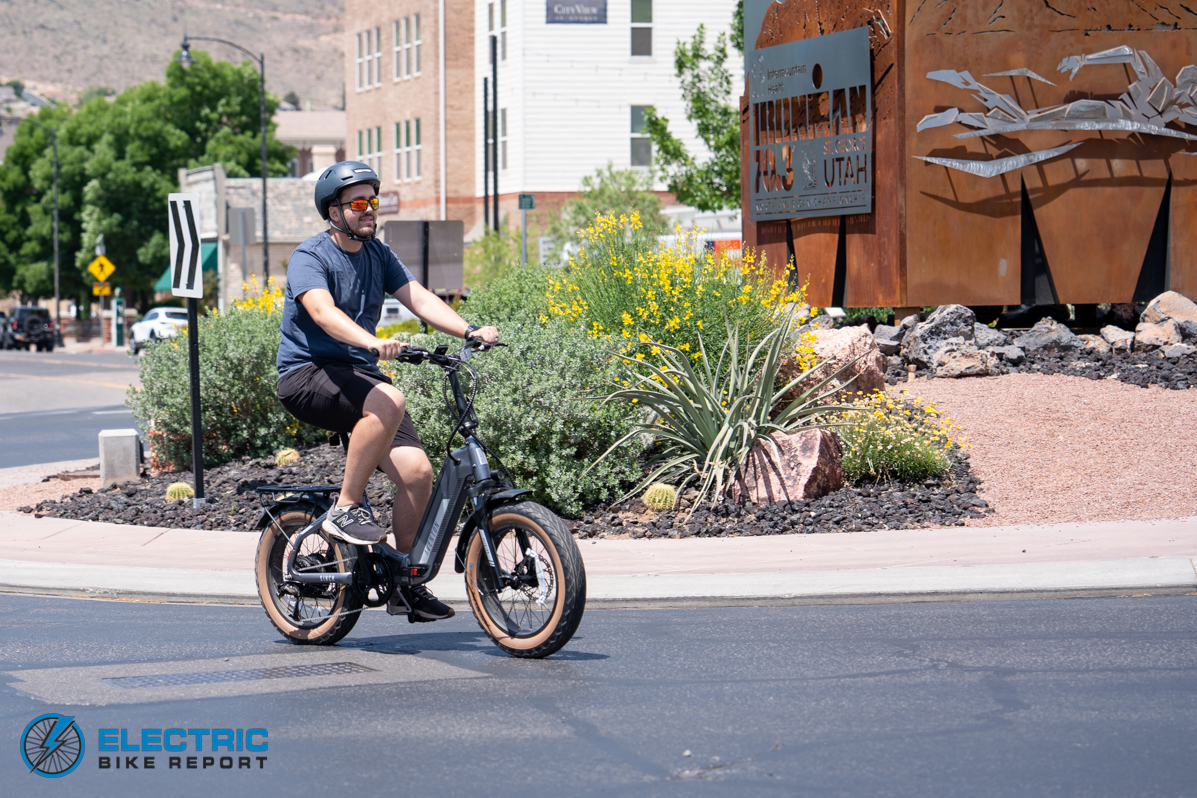
The Sinch.2 prioritizes being a functional e-bike first, with folding as a secondary feature.
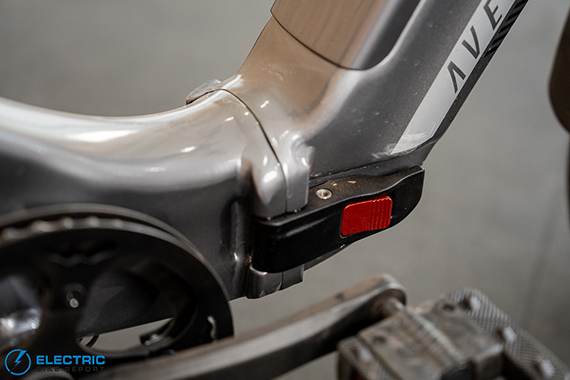
The bike’s central hinge mechanism is the main method it uses to reduce down in size.
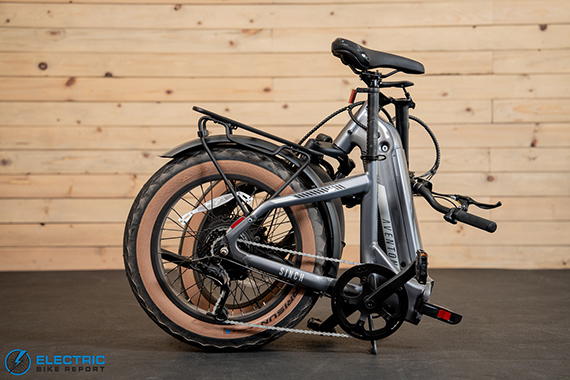
The collapsed Sinch.2 measures roughly 34” L x 24” W x 31” H.
While Aventon offered the previous model in both a high-step and step-thru frame design, the second generation of the Sinch is currently only offered with a step-thru frame. As it stands (pun intended), this makes the bike easily accessible for riders who may have difficulty swinging their leg over the saddle. The Sinch.2 retains the original model’s standover height of just over 15”.
As with many folding e-bikes, the Sinch.2 uses a central hinge mechanism, a collapsible stem, and folding pedals to reduce its size. Both the main hinge and that on the stem have locks that must be released before they can move. Both are also simple mechanisms that felt solid and stable when locked, but we did notice the lever for the central hinge on our test bike was relatively stiff and required an extra measure of strength to release.
When we collapsed the bike, we were able to reduce its size to roughly 34” L x 24” W x 31” H, which is relatively average when compared to similar folding e-bikes we’ve tested. The Sinch.2 weighs a bit more than average, however, at a fairly substantial 68 lbs. Its battery can be removed to make lifting and loading easier, but the remaining frame is still a significant amount of weight – something to be aware of if you are looking for a folding bike you plan to move regularly.
Aventon Sinch.2 ST Review: Circuit Speed Test
As a Class 2 e-bike, the Sinch.2 offers both throttle and pedal-assisted speeds of up to 20 mph. It also features a 500W (750W peak) rear-hub motor, an 8-speed Shimano drivetrain, and Aventon’s recently adopted convention of 4 pedal-assist settings; Eco, Tour, Sport, and Turbo modes. To get a feel for these elements of the bike, we performed a Circuit Test, which you can read more about in the graphic above.
With no motor assistance, the Sinch.2 moved fairly well on flat ground, but it was not the easiest bike to pedal uphill due to its weight. In Eco Mode (and above), however, the motor’s engagement was immediate thanks to the bike’s torque sensor, and it was also impactful. As our data shows, the bike was easily able to approach its maximum motor-assisted speed even in its lowest PAS setting.
As is typical with e-bikes that use torque sensors, the Sinch.2 responds based on the amount of effort put in by the rider. The bike’s four PAS settings dispense greater amounts of power with each pedal stroke in its higher levels, but the motor’s output is not capped (as with many cadence sensors).
For this reason, our average speed data from this test does not indicate or suggest much difference between the various PAS settings – though to be clear, there is a noticeable change in the bike’s feel when you’re riding it. Getting up to speed is much faster in Turbo Mode than it is in Eco Mode, and it is possible to feel greater inertia from each pedal stroke on the higher end of the settings as well. Your speed can be controlled more through the gear you ride in and how heavy your pedal strokes are and less through the PAS setting you choose.
As with all of Aventon’s e-bikes, the Sinch.2 pairs with the brand’s app for ride data tracking, access to the Aventon community, and more – but it’s worth noting that unlike other bikes like the Aventure.2, the Sinch cannot be unlocked to speeds above 20 mph. Personally, I found the bike to feel like it easily could achieve higher speeds, and I imagine that the graph above would likely display more differentiation between its average speeds in its different PAS settings, but I’m also not unhappy about such a limitation on a folding e-bike just for added safety and peace of mind.
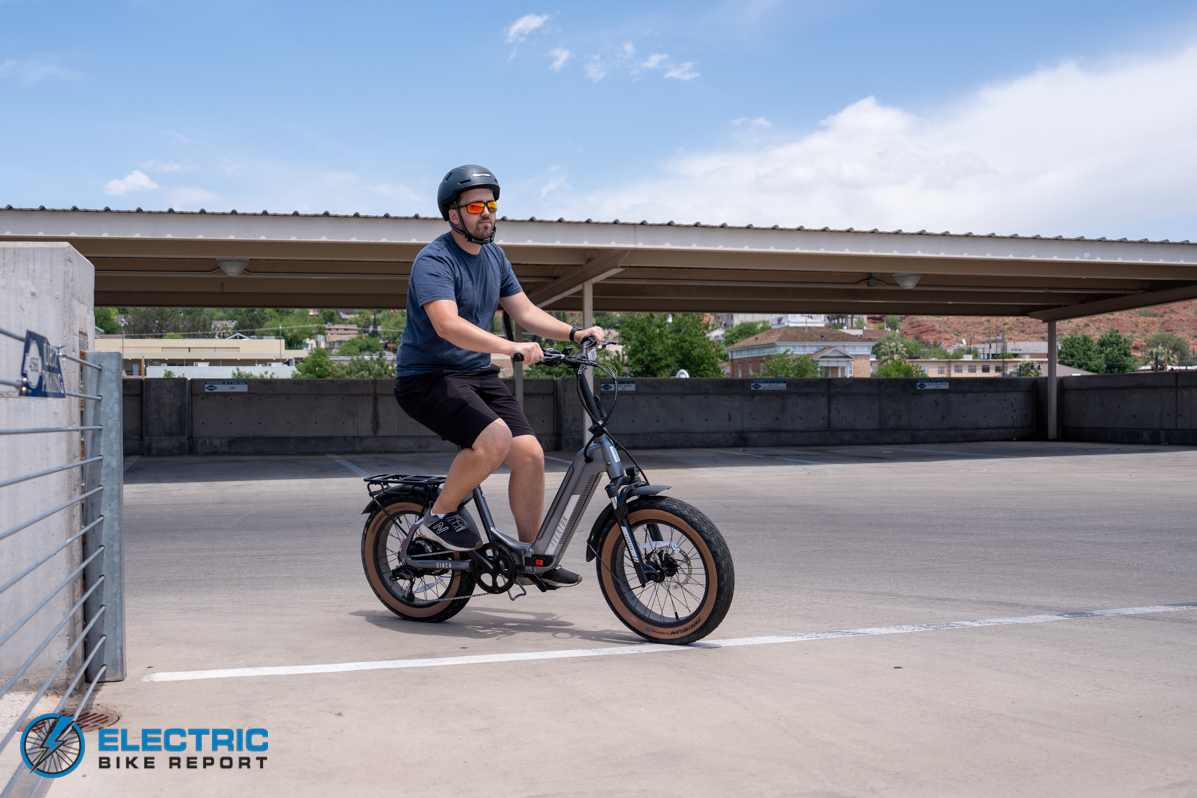
The bike’s step-thru frame design looks great, but also makes it much easier to use.
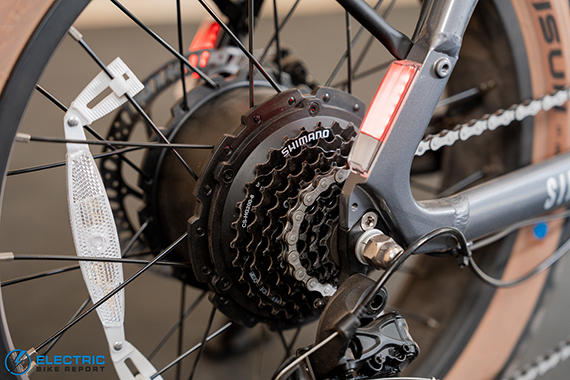
A 500W rear-hub motor packs plenty of punch for a bike of this size.
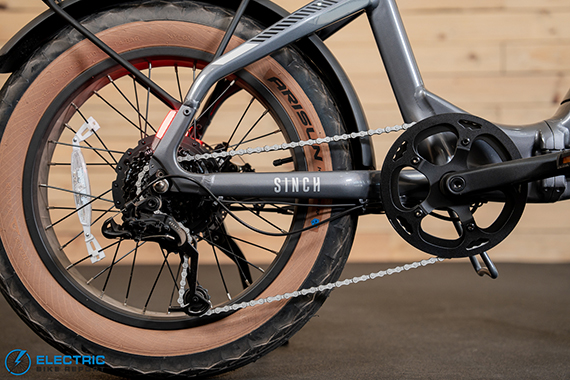
The Sinch.2 now features an 8-speed drivetrain instead of the 7-speed on the original version of the bike.
Aventon Sinch.2 ST Review: Range Test & Battery Performance
To evaluate the Sinch.2’s fully integrated 48V, 14 amp-hour (Ah) or 672 watt-hour (Wh) battery, as well as the efficiency of its pairing with the bike’s 500W motor, we performed two Range Tests, which are described in the graphic above.
Our test riders traveled over 36 miles in Turbo Mode, and nearly 59 miles in Eco Mode, which balances out well next to Aventon’s advertised range of 55 miles.
Before breaking down our data further, it should be noted that 36-59 miles is a completely respectable distance for any e-bike to travel. Considering that our results from the Circuit Test portion of this Aventon Sinch.2 review showed a practical amount of power with the bike in Eco Mode, it’s entirely reasonable to think that Sinch.2 owners could regularly achieve distances toward the top end of our results before needing to recharge the battery.
To get a bit more technical, our data proved that the Sinch.2’s motor/battery pairing is efficient, thanks in large part to its torque sensor. The fact that the bike’s motor requires the rider to apply some effort means that it does not have to draw as much energy from the battery.
Additionally, while we explain the relationship between battery watt-hours and motor watts in our guide to e-bike batteries, we expected to get about an hour and twenty minutes of travel time from the Sinch.2’s battery and motor in Turbo mode. Our test rider pedaled for nearly an hour longer than we expected!
Perhaps most importantly, however, is the immediate comparison between the Sinch.2 and the original version of the bike. The first iteration of the Sinch used a cadence sensor, but also came equipped with a 500W rear hub motor and a 672Wh battery. Our results from that bike’s Range Tests were 28 to 39 miles in PAS 5 and PAS 3 respectively, which shows a difference in ten to twenty miles of additional range with the upgraded Sinch.2. That’s phenomenal!
Aventon Sinch.2 ST Review: Hill Test
Our Hill Test, explained above, allowed us to evaluate the Sinch.2’s ability to handle steep inclines using both its throttle and pedal-assist system. When compared to similar folding e-bikes we have tested, the Sinch.2 performed solidly in both tests.
On throttle-only power, we climbed Hell Hole Trail in just 1 minute and 18 seconds, traveling 13.9 miles per hour on average. This is currently the best throttle-only result we’ve seen from among the folding e-bikes we have tested! Our results in Turbo mode were only slightly less impressive, with an average speed of 14.9 mph and a time from start to finish of 1 minute and 13 seconds.
It’s worth noting that, at least at time of writing, all of the other folding e-bikes we have tested also have 500W rear hub motors, though their torque output varies. Many of those other e-bikes also weigh less than the Sinch.2, and most use cadence sensors that require less input from the rider.
The Sinch.2’s results in this test are already relatively impressive, but with those additional things in mind, we were ultimately quite pleased with the bike’s performance on this test.
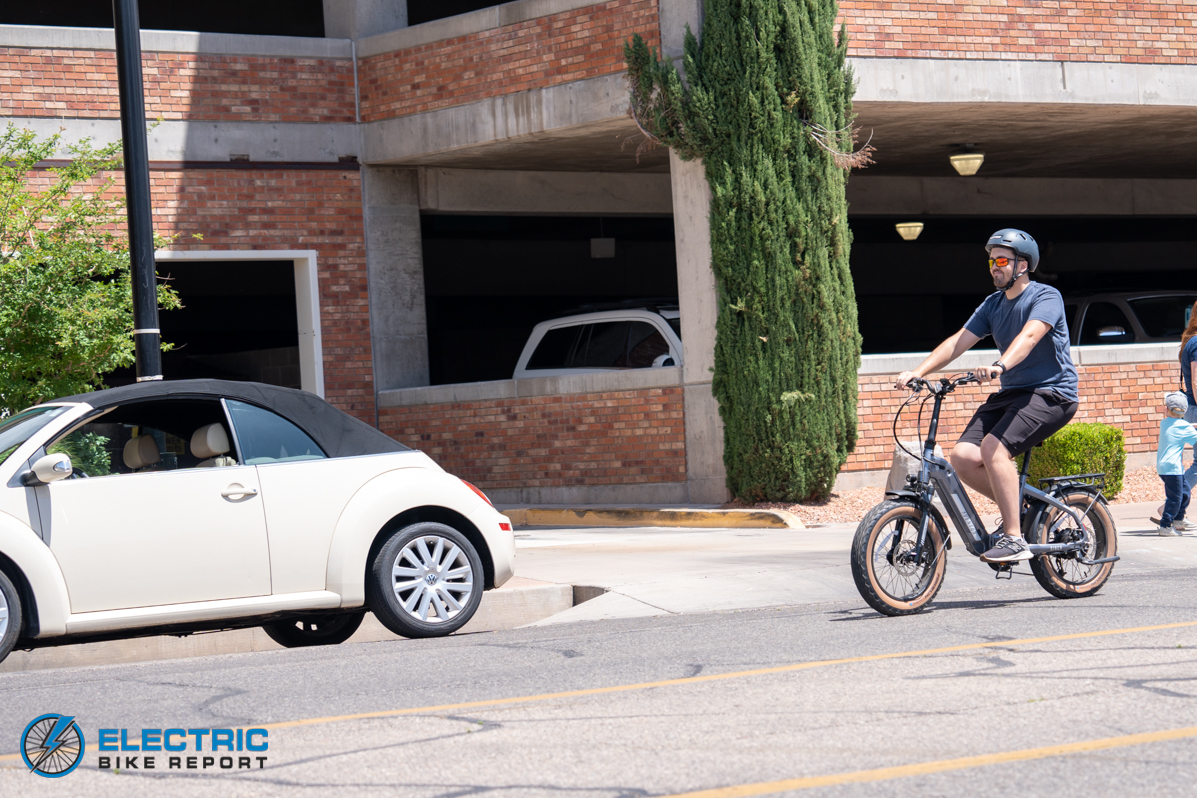
With fat tires and a front suspension fork, the Sinch.2 makes for a comfortable ride around town.
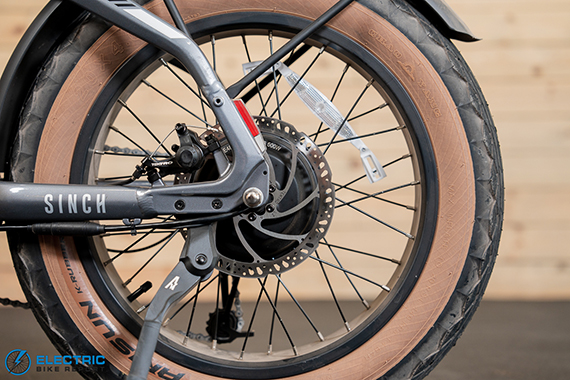
Despite their street tread, the Sinch.2’s 20”x4” fat tires handle light off-roading surprisingly well.
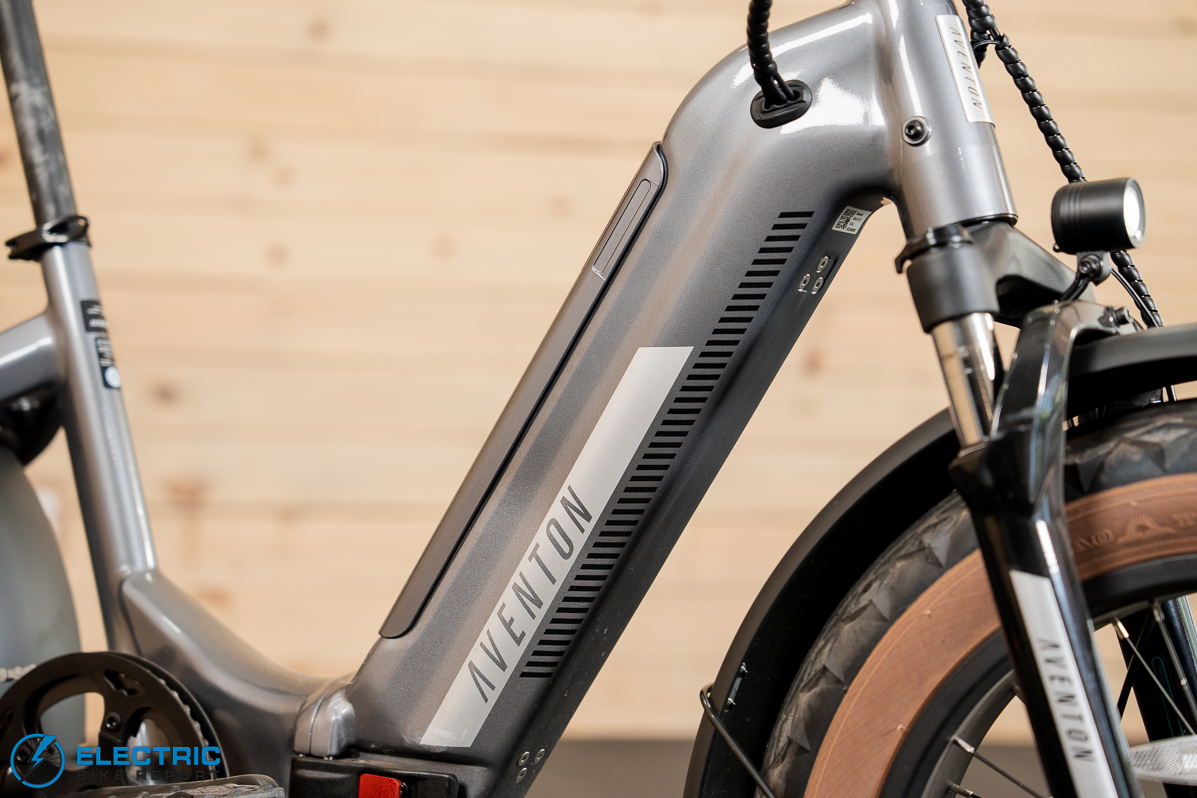
The fully integrated 48V, 672 Wh battery looks clean while providing enough power for long rides.
Aventon Sinch.2 ST Review: Safety and Brake Test
After gathering three sets of data, we calculated an average stopping distance of 20’-1”. This result is slightly better than our current running average across all of the folding e-bikes we have tested – which is solid performance for a mechanical brake system!
When considering the feel of the bike’s brakes, this result is unsurprising; I personally assumed they were hydraulic disc brakes after my first test ride because of how responsive they were. The bike itself was stable when braking, which I attribute to its 20”x4” fat tires and also its weight. I noticed that the tires had a tendency to squeal when braking because of their minimal street tread, but this didn’t more than a second or two thanks to the effectiveness of the brakes.
In general, we typically prefer to see hydraulic disc brakes on e-bikes weighing 68 lbs (or often much more), but considering the performance of the Sinch.2’s brakes as they are, we have no complaints. We did reach out to the company to ask why mechanical brakes were used, and they explained that on folding bikes, cables and tubes can get pinched due to the folding mechanisms of the bike. Hydraulic disc brakes can react poorly to this, but mechanical systems like that on the Sinch.2 are able to hold up much better in the event of a pinch.
In addition to good brakes and the turn signals I have discussed at length in previous sections of this Aventon Sinch.2 review, the bike also includes brake lights and a small headlight. These are common features, but once again, as advocates of safety, we appreciate even the little things.
Aventon Sinch.2 ST Review: Ride Comfort & Handling, Cockpit, and More
We’ve generally been very happy with the ride comfort of the other Aventon e-bikes we’ve tested, and this holds true with the Sinch.2 as well. In terms of contact points, the standard Aventon saddle is always a welcome sight (and seat), and despite not being ergonomically-shaped, the bike’s textured rubber grips were comfortable as well. The folding pedals are relatively standard fare among folding e-bikes, but they did seem larger than those on some other bikes we’ve tested.
The Sinch.2’s small, fat tires provide plenty of stability and allow for nimble handling, though personally, I found that the bike cornered better at slower speeds due to what felt like a relatively high center of gravity. The bike’s telescoping, collapsible stem is shorter than we’ve seen on some other folding e-bikes, which helps to reduce the flex we often see accompany in these components. The combination of 4” diameter tires and a front suspension fork worked well to absorb bumps and made for a smooth ride. The fork felt a bit too loose right out of the box, but a couple of clicks on its preload adjustment stiffened its travel enough for my preferences.

We’re big fans of the standard full-color Aventon LCD. It looks great and it’s easy to read!
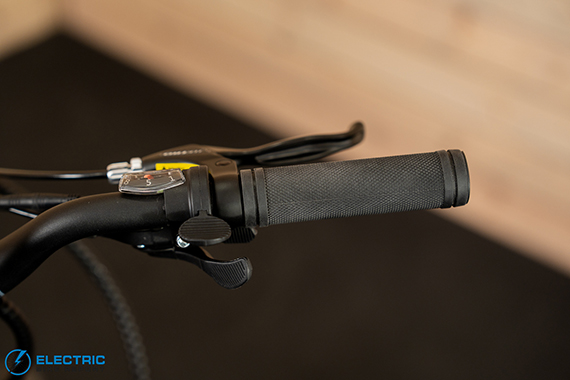
The Sinch.2’s right handlebar hosts a single-unit shifter and throttle lever. It saves on space but takes some getting used to.
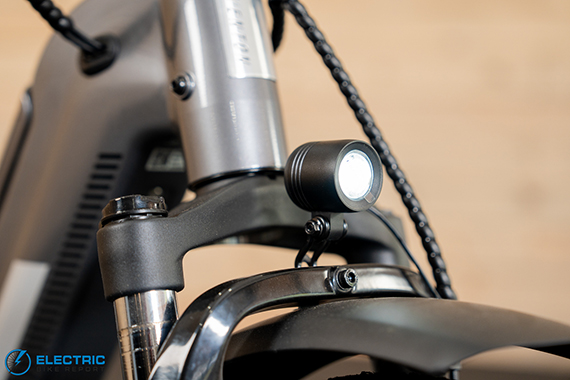
A front suspension fork with 45 mm of travel softens dirt roads and rough pavement.
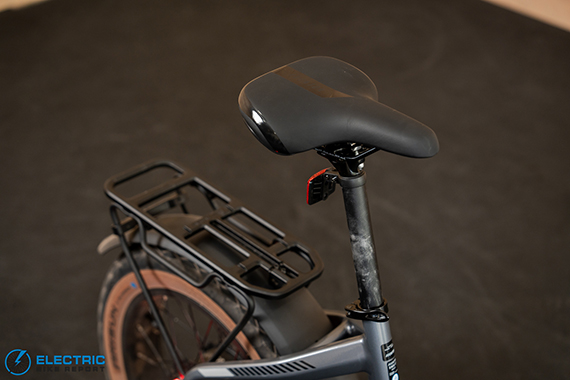
The Sinch.2 includes the standard Aventon saddle and a rear rack that can hold up to 55 lbs.
The Sinch.2’s cockpit layout is simple but (mostly) effective. Aside from brake levers, the right handlebar carries the bike’s shifter and throttle lever; both of these components are integrated into a single Aventon-branded module. I found that it worked well overall, though the proximity of the levers did take some getting used to. The left bar hosts the bike’s control panel, which is standard across all of the brand’s models. This gives quick access to the bike’s lights, turn signals, PAS system adjustment, and more.
As with all Aventon models, the Sinch.2 ships with the brand’s standard full-color LCD. This is one of our favorite displays, just due to its color scheme and ease-of-reading, and the addition of turn signal indicators and the brand’s newer 4-stage PAS just adds to an already great element.
Additionally, the bike includes a rear cargo rack that can accommodate up to 55 lbs of gear, and is compatible with cargo-carrying accessories that Aventon offers.
Aventon Sinch.2 ST Review: Summary / Where to Buy
Torque sensors and turn signals remain relatively uncommon features among other similarly-priced e-bikes, and we appreciate that Aventon is leading the charge toward making these elements standard on models in the $1500-$2000 price range. The addition of these features on the Sinch.2 makes for just another feather in their cap!
We were pleased to find that the Sinch.2 felt and performed very much like a non-folding e-bike, while still offering the flexibility (literally) granted by its mechanisms to collapse in size. It should be remembered that the bike is on the heavier end of the spectrum when it comes to folding e-bikes, so it may not be the most well-suited to daily packing and unpacking, but the option exists for those who may wish to bring it along on a road trip or family vacation.
There are typically some tradeoffs with folding e-bikes that affect at least some elements of their ride quality or performance, but we were extremely satisfied with the Sinch.2’s ability to balance all of these elements. Aventon seems to have focused primarily on just making a good bike that also happens to fold, instead of making sacrifices to put more emphasis on the folding aspect. For this reason, we think the Sinch.2 would be an excellent choice of e-bike for someone who might like the increased flexibility granted by the bike’s folding mechanism, but who also prioritizes performance, ride feel, comfort, and more.
Happy Riding! Make sure to let us know if you have any questions down in our comments section or if you think we left anything out in this review of the Aventon Sinch.2 ST.





I just (Jan. 2024) bought two Sinch 2 ebikes. I wanted to mention that I was able to go into the app and turn up the max speed to 25 mph. The actual max speed the bike will reach is directly related to the amount of charge in the battery. At full charge, I can easily reach 25 mph. At 50% charge the speed is closer to 22-23 mph.